Gudi Padwa, the Hindu New Year celebrated predominantly in Maharashtra and parts of India, marks the onset of spring and the beginning of the Chaitra month in the Hindu calendar. This auspicious festival symbolizes new beginnings, prosperity, and victory. In 2025, Gudi Padwa will be observed with great enthusiasm, offering an opportunity for devotees to embrace traditions, perform rituals, and strengthen their spiritual journey from the comfort of their homes.
Significance of Gudi Padwa in the Puranas
Gudi Padwa, celebrated on the first day of the Chaitra month, marks the beginning of the Hindu New Year and holds profound spiritual and historical significance. This auspicious festival is deeply rooted in Hindu scriptures, particularly the Puranas, and is associated with several divine events.
1. The Coronation of Lord Rama

According to the Ramayana, after Lord Rama’s victory over Ravana and his return to Ayodhya following 14 years of exile, the citizens of Ayodhya celebrated this joyous occasion by hoisting victory flags (Gudhi) in their homes. The festival of Gudi Padwa is thus commemorated as the day of Rama’s coronation (Pattabhisheka), symbolizing the victory of Dharma (righteousness) over Adharma (unrighteousness). The Gudi (a decorated flag) raised during the festival is believed to represent the royal banner of Lord Rama, signifying triumph, prosperity, and divine blessings.
2. The Creation of the Universe by Lord Brahma

As per the Brahma Purana, Gudi Padwa is the day when Lord Brahma, the creator of the universe, initiated the cycle of time (Kalachakra) and manifested creation. It is believed that after the great deluge (Pralaya), Brahma reconstructed the world and established order, making this day the beginning of time itself. The significance of this event makes Gudi Padwa an ideal time for new beginnings, spiritual growth, and invoking divine grace.
3. The Victory of King Shalivahana
The Bhavishya Purana mentions that on this day, King Shalivahana, an ancient ruler of India, defeated the Sakas and established his kingdom. This marked the beginning of the Shalivahana Shaka era, which is still used in Hindu calendars today. The festival, therefore, also symbolizes the rise of a powerful and righteous ruler and is associated with strength, valor, and justice.
4. The Arrival of Spring and the Agricultural New Year
The festival aligns with the Vasant Ritu (spring season) and signifies the renewal of life. It marks the time for the new harvest, especially in Maharashtra, where farmers celebrate nature's bounty. This aspect of the festival is deeply connected to the worship of Mother Earth and gratitude for sustenance provided by nature.
Preparations for Gudi Padwa
1. Clean and Decorate Your Home

Purity and cleanliness are integral to Hindu rituals. To remove negative energies, begin the day by thoroughly cleaning your home.
- Sweep and mop the floors, dust furniture, and ensure all rooms are tidy.
- Sprinkle Gangajal (holy water) at the entrance and in each room to purify the surroundings.
- To welcome divine energy, create vibrant rangoli at the doorstep using turmeric, vermillion, colored powders, and flower petals.
- Hang fresh mango leaves and marigold garlands at the entrance, symbolizing prosperity and positivity.
- Decorate the pooja area with oil lamps (diyas), fragrant flowers, and incense sticks to create a serene spiritual ambiance.
2. Wear Traditional Attire
Dressing in traditional Maharashtrian attire enhances the festive spirit and deepens cultural appreciation. Wearing vibrant clothes on Gudi Padwa signifies joy, prosperity, and respect for traditions.
- For Women:
- Opt for a traditional Nauvari saree, a nine-yard saree draped in a unique style that allows easy movement.
- Choose bright colors like saffron, green, red, or yellow, which are considered auspicious.
- Accessorize with gold jewelry, including a mangalsutra, nath (nose ring), bangles, and earrings.
- Adorn your hair with gajra (jasmine flower garland) to complete the festive look.
- Apply a traditional bindi and use kohl to enhance your eyes.
- For Men:
- Wear a Kurta-Pajama or Dhoti-Kurta, preferably in silk or cotton fabric.
- Pair it with a Pheta, a saffron or red turban, a symbol of honor and pride in Maharashtrian culture.
- Accessorize with a Rudraksha mala or a simple gold chain for an elegant touch.
- Apply a tilak made of kumkum and sandalwood paste on the forehead as a mark of devotion.
Dressing up traditionally enhances the festive ambiance and instills a sense of pride in one's cultural heritage. Encourage children to wear ethnic clothes as well, helping them connect with the festival's significance from a young age.
Step-by-Step Rituals of Gudi Padwa
Gudi Padwa is a festival of new beginnings, prosperity, and victory. Its rituals are deeply symbolic and rooted in ancient Hindu traditions.
1. Raising the Gudi – Invoking Prosperity
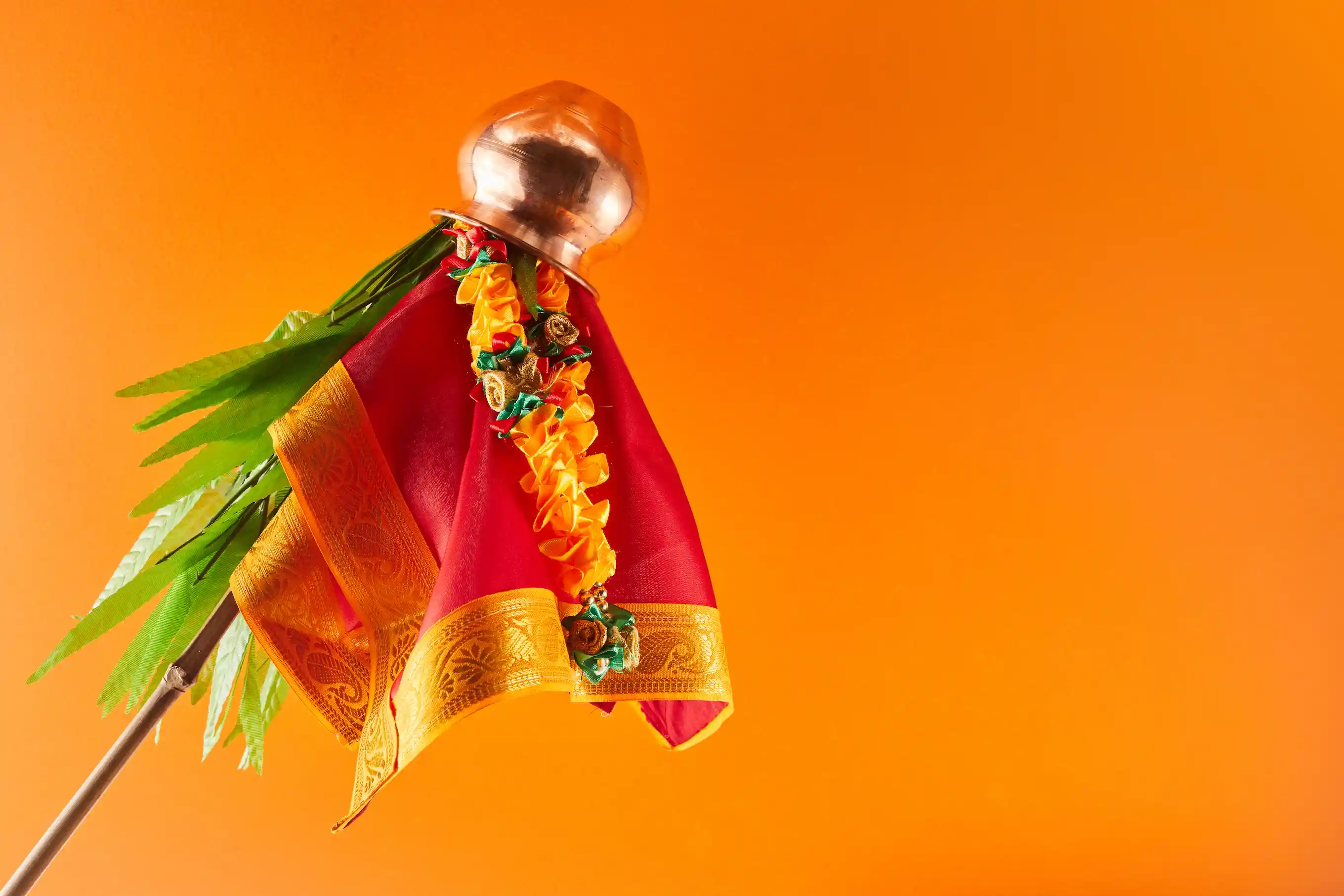
The most significant ritual of Gudi Padwa is the hoisting of the Gudi, a sacred flag that represents victory, divine blessings, and prosperity. This tradition dates back to Lord Rama’s victorious return to Ayodhya and Lord Brahma’s creation of the universe. The Gudi is a powerful emblem that wards off negative energies and welcomes good fortune.
How to Prepare the Gudi:
Each element of the Gudi holds spiritual significance:
- Take a bamboo stick (representing stability and resilience).
- Bamboo is revered in Hindu traditions as a symbol of growth and longevity. In the Skanda Purana, it is mentioned as an auspicious plant that attracts divine blessings.
- Wrap a silken yellow or saffron cloth around the top.
- Saffron color: Represents sacrifice, valor, and devotion, often associated with Hindu warriors and sages.
- Yellow color: Represents prosperity, wisdom, and divine grace, associated with Lord Vishnu and Goddess Lakshmi.
- Tie auspicious items to the Gudi:
- Mango leaves – Considered sacred in the Puranas, mango leaves attract positive energy and symbolize fertility and well-being.
- Neem leaves – Mentioned in the Atharva Veda for their medicinal and purifying properties. They ward off evil forces and protect the household from diseases.
- Sugar garland (Gaathi) – Symbolizes sweetness and joy in life and offers gratitude to the divine.
- Marigold flowers – Traditionally used in Hindu rituals, marigolds represent auspiciousness and divine blessings.
- Place an inverted silver or copper Kalash (pot) on top.
- Symbolizes divine energy and abundance. The Kalash (sacred pot) is often used in Hindu rituals as a vessel of life and prosperity.
- Silver Kalash – Associated with Goddess Lakshmi and financial prosperity.
- Copper Kalash – Believed to have positive energy that purifies the surroundings.
- Position the Gudi outside your home.
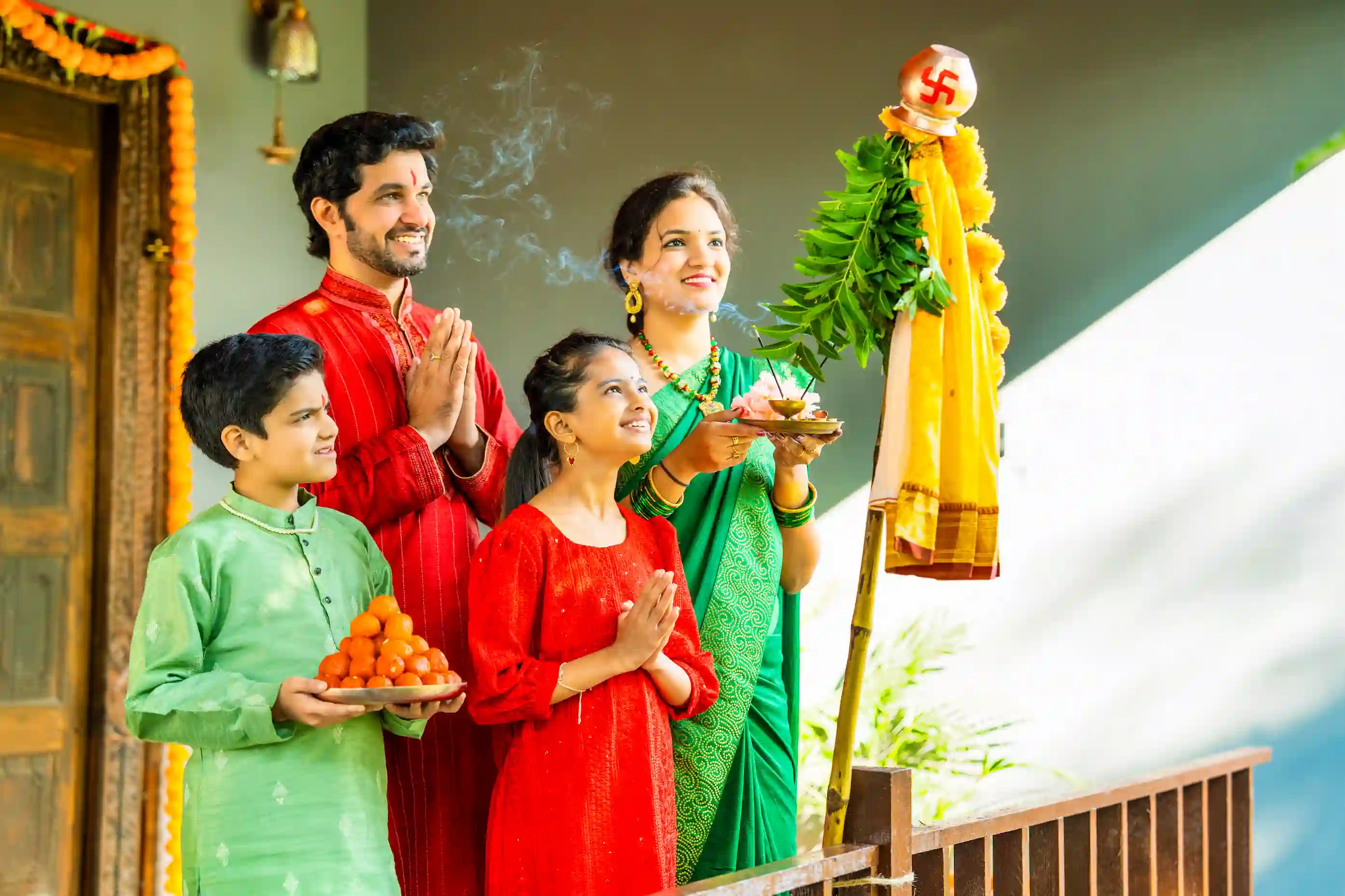
- It should be placed at the entrance or a window on the right side, which is considered the active side (Pingala Nadi) in Vedic traditions and is associated with solar energy and divine power.
- The Gudi should face upwards, signifying growth, positivity, and success.
- Offer prayers and chant sacred hymns.
- Shri Ram Raksha Stotra – A powerful hymn that invokes the protection and blessings of Lord Rama.
- Vishnu Sahasranama: Reciting Lord Vishnu's 1000 names is believed to bestow divine grace, peace, and prosperity.
- Brahma Stotra – Honoring Lord Brahma for creating the universe on this auspicious day.
Spiritual Benefits of Hoisting the Gudi:
✅ Brings prosperity – Symbolizes victory and the beginning of auspicious times.
✅ Wards off negative energies – The sacred elements of the Gudi act as a protective shield.
✅ Invokes divine blessings – Ensures success, happiness, and spiritual growth in the new year.
✅ Encourages gratitude and devotion – A reminder of the triumph of good over evil.
Raising the Gudi on Gudi Padwa is a deeply spiritual act that aligns one’s life with divine cosmic energies, ensuring success, well-being, and happiness throughout the year. 🌿✨
2. Perform Gudi Padwa Puja
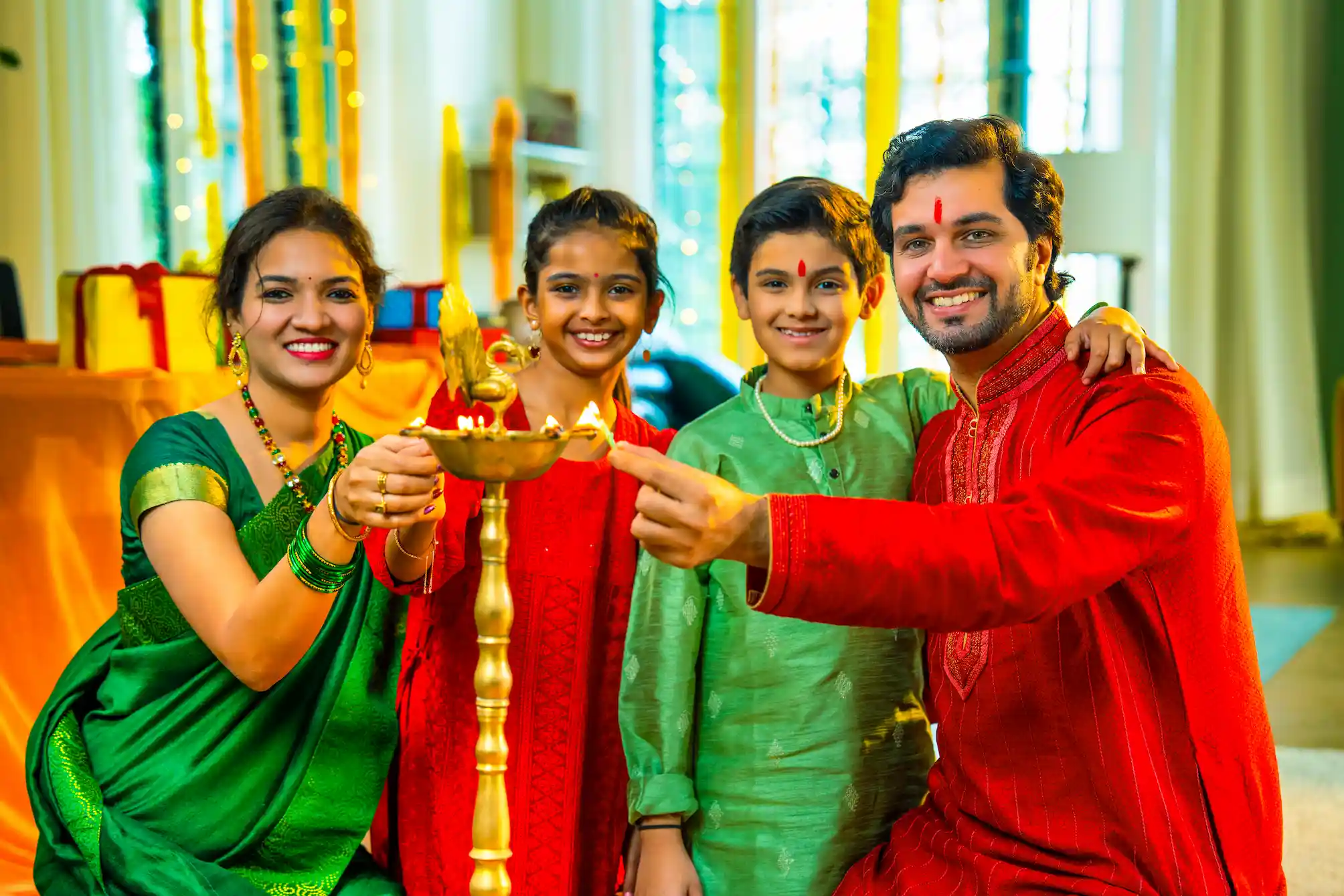
After setting up the Gudi, offer a traditional Gudi Padwa Puja to seek divine blessings.
Puja Essentials:
- A lamp (Diya) with ghee or sesame oil
- Fresh flowers and turmeric-kumkum
- Incense sticks (Agarbatti) and sandalwood paste
- Coconut and sweets like Puran Poli or Shrikhand-Puri
Steps to Perform the Puja:
- Light the lamp and offer Naivedya (Prasad) to the deities.
- Recite Gudi Padwa Aarti, followed by Mantras dedicated to Lord Vishnu and Lord Rama.
- Seek blessings by bowing before the Gudi and distributing Prasad among family members.
3. Consume Neem and Jaggery Prasad
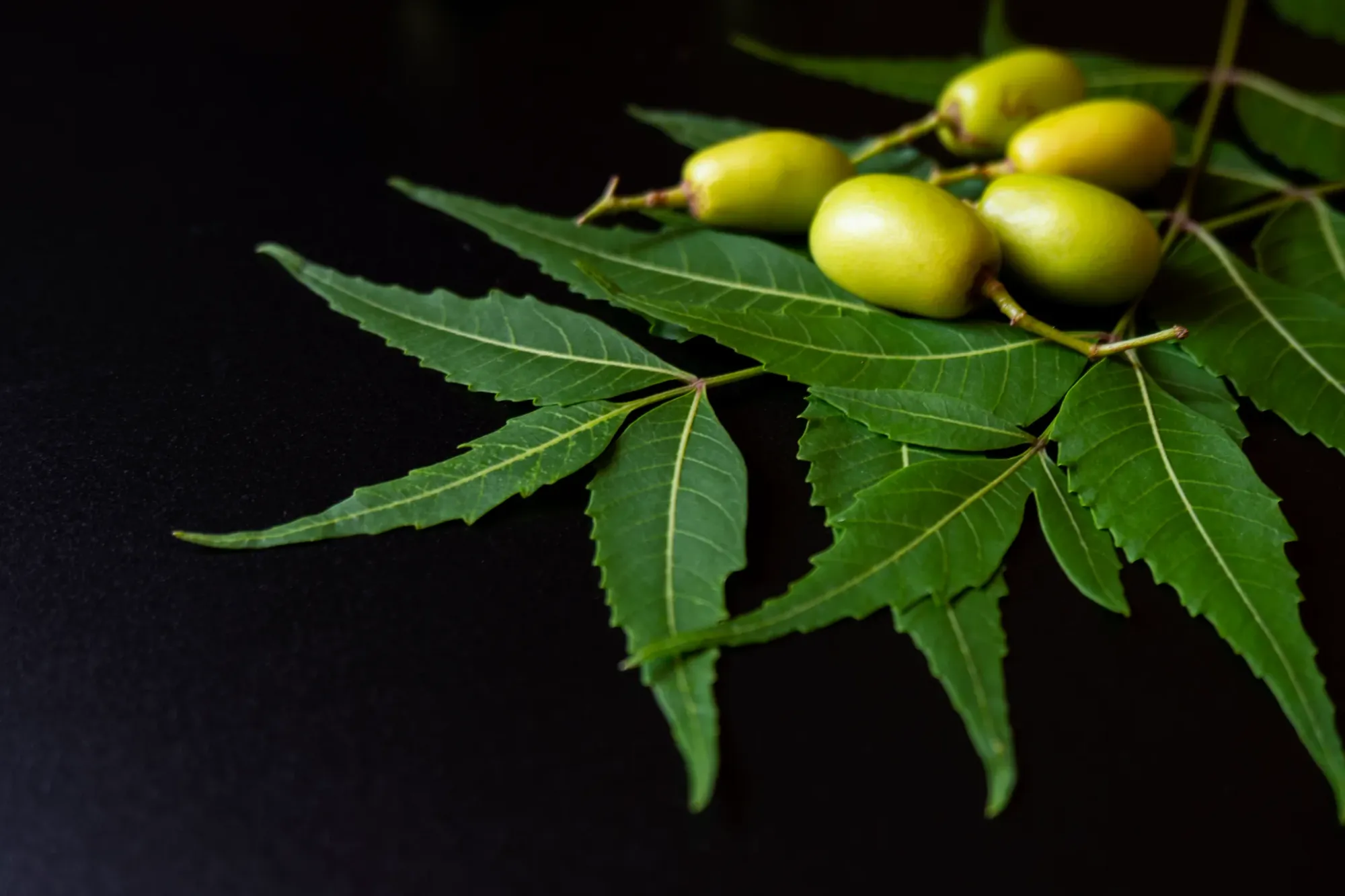
Eating a mixture of neem leaves, jaggery, and tamarind on Gudi Padwa signifies embracing both the bitter and sweet life experiences. It is believed to purify the blood and boost immunity while symbolizing balance and resilience in the new year.
Festive Delicacies for Gudi Padwa
A festival is incomplete without traditional dishes. Here are some delightful recipes to prepare at home:
1. Puran Poli
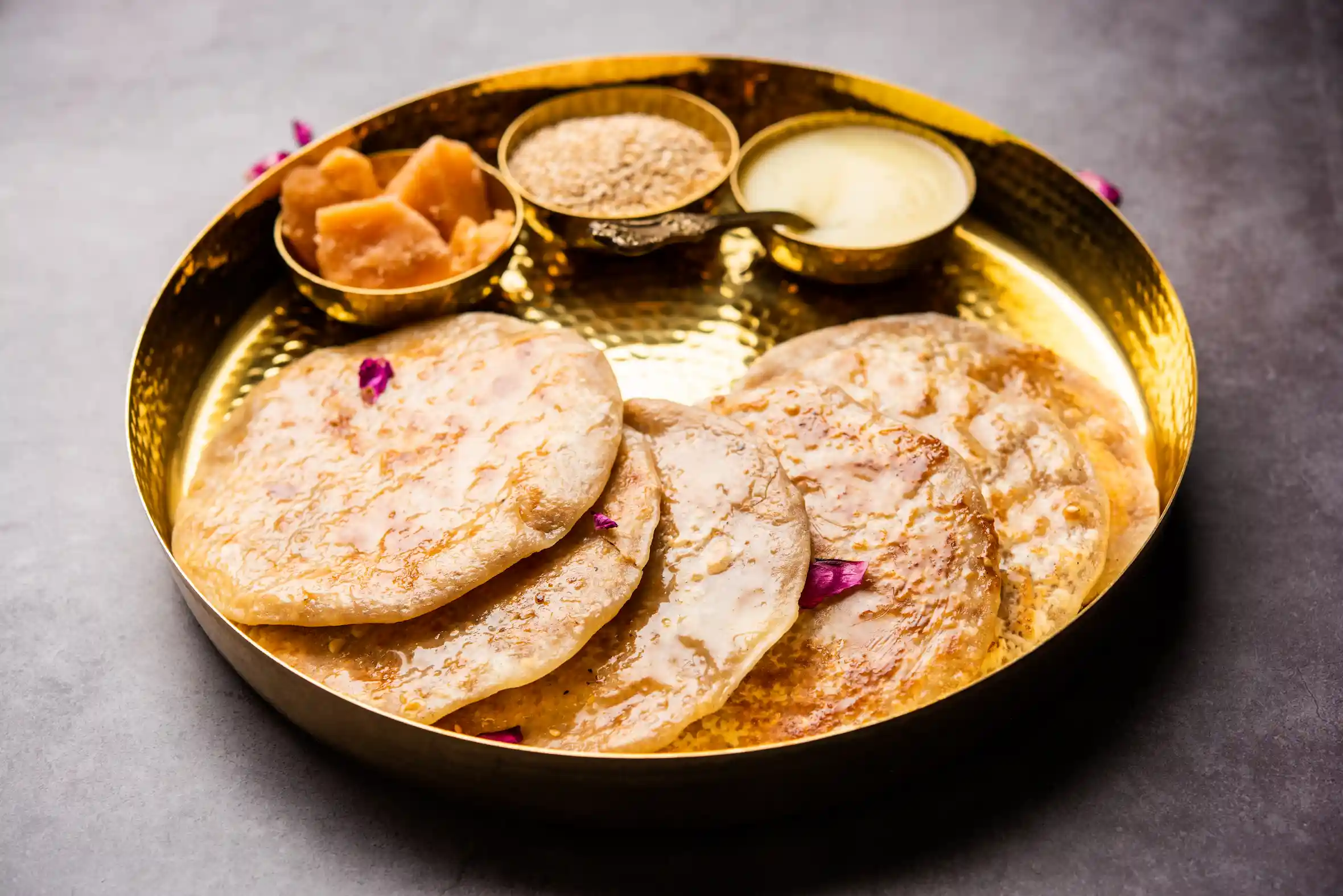
Puran Poli is a Maharashtrian delicacy made with chana dal, jaggery, and wheat flour. It is a must-have during Gudi Padwa.
- Cook chana dal and mash it with jaggery.
- Add cardamom and nutmeg powder for enhanced flavor.
- Stuff this mixture into wheat dough, roll it, and roast it with ghee.
2. Shrikhand with Puri
This cooling and delicious dessert, made with strained yogurt, sugar, saffron, and nuts, is paired with crispy puris to enhance the festive mood.
3. Kesar Bhat (Saffron Rice)
A sweet dish with rice, saffron, ghee, and dry fruits symbolizes prosperity and auspiciousness.
Engaging in Spiritual and Cultural Activities
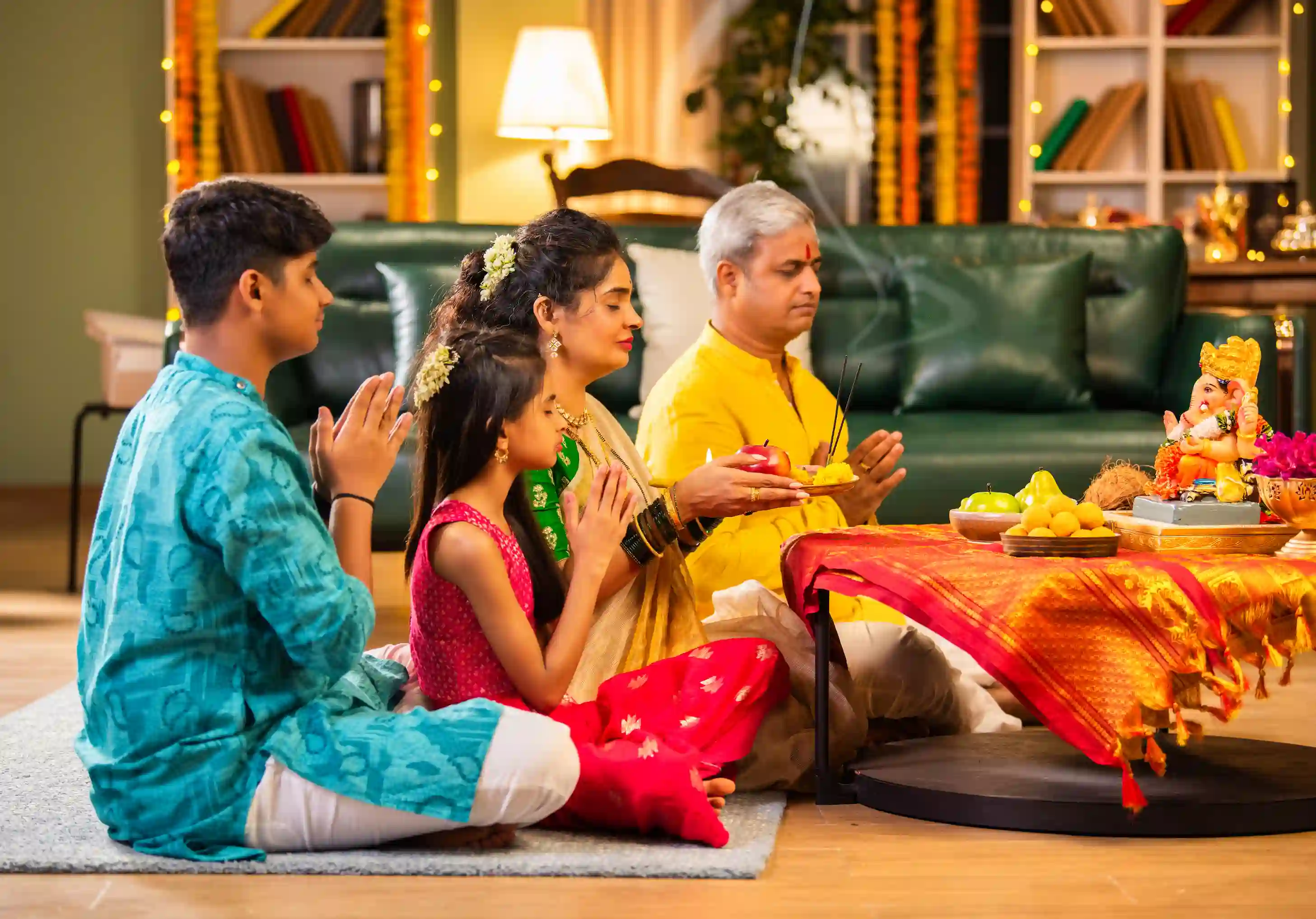
1. Reciting Holy Scriptures
Gudi Padwa is an excellent occasion to engage in spiritual reading and chanting:
- Recite Shri Ramcharitmanas or Bhagavad Gita, Chapter 2 (which speaks about life’s purpose and new beginnings).
- Chant Shri Vishnu Sahasranama for divine blessings and positivity.
2. Storytelling for Children
Educate children about the significance of Gudi Padwa by narrating stories of Lord Rama’s return to Ayodhya, Lord Brahma's creation of the universe, and the historical victories of great Maratha warriors.
3. Charity and Service (Seva)
Giving to the needy on Gudi Padwa enhances spiritual merit:
- Donate food, clothes, or money to underprivileged families.
- Distribute sweets to neighbors and spread festive joy.
- Serve at temples or organize a small bhajan gathering at home.
Join the Grand Hindu New Year Celebrations at Radha Krishna Temple of Dallas!
As you prepare to celebrate Gudi Padwa at home, we warmly invite you to join the Hindu New Year celebrations at the Radha Krishna Temple of Dallas on Saturday, March 29, 2025. This auspicious event offers an excellent opportunity to partake in traditional rituals, cultural programs, and community festivities.
Event Highlights:
- Navchandi Havan (9:00 AM - 6:00 PM): A powerful Vedic ritual invoking the blessings of Goddess Durga and the Nav Chandi deities for spiritual upliftment, peace, and prosperity.
- Valmiki Sunderkand Recitation (10:00 AM): Experience the divine narration of Sunderkand, filling hearts with hope and inspiration.radhakrishnatemple.net
- Open Stage / Cultural Program (4:00 PM): Celebrate our rich cultural heritage through music, dance, and artistic expressions by community members of all ages.
- Panchang Sravanam (6:00 PM): Recitation and explanation of the new year's Panchang, detailing auspicious moments and predictions.
- Aarti & New Year Special Archana (7:00 PM): Join the collective prayers, kirtans, and special archana to begin the New Year with devotion.radhakrishnatemple.net
- Mahaprasad: Conclude the celebration by sharing a blessed meal with the community.
Location:
Radha Krishna Temple of Dallas
1450 N. Watters Road, Allen, TX 75013 radhakrishnatemple.net
For more details and to register for the event, please visit the Radha Krishna Temple's official website.
Celebrate this Gudi Padwa with us, embracing the spirit of renewal and community, as we welcome the Hindu New Year together.
Conclusion
Gudi Padwa is not just a festival but a spiritual reminder of embracing new beginnings with enthusiasm and devotion. Celebrating at home with proper rituals, delicious prasad, and family bonding can make the day deeply fulfilling and auspicious. Whether through hoisting the Gudi, offering prayers, cooking traditional sweets, or engaging in charity, each aspect of Gudi Padwa brings joy, prosperity, and divine grace into our lives.
As you celebrate Gudi Padwa in 2025, may your home be filled with peace, happiness, and spiritual growth. Wishing you and your family a blessed and prosperous Hindu New Year!
For more insights into Hindu festivals, spiritual teachings, and devotional activities, visit Radha Krishna Temple of Dallas and stay connected with divine wisdom!
